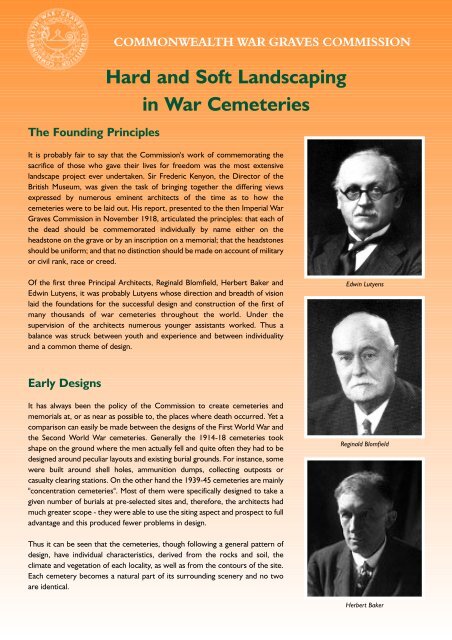Hard and Soft Landscaping in War Cemeteries
Hard and Soft Landscaping in War Cemeteries
Hard and Soft Landscaping in War Cemeteries
Create successful ePaper yourself
Turn your PDF publications into a flip-book with our unique Google optimized e-Paper software.
The Found<strong>in</strong>g Pr<strong>in</strong>ciples<br />
It is probably fair to say that the Commission's work of commemorat<strong>in</strong>g the<br />
sacrifice of those who gave their lives for freedom was the most extensive<br />
l<strong>and</strong>scape project ever undertaken. Sir Frederic Kenyon, the Director of the<br />
British Museum, was given the task of br<strong>in</strong>g<strong>in</strong>g together the differ<strong>in</strong>g views<br />
expressed by numerous em<strong>in</strong>ent architects of the time as to how the<br />
cemeteries were to be laid out. His report, presented to the then Imperial <strong>War</strong><br />
Graves Commission <strong>in</strong> November 1918, articulated the pr<strong>in</strong>ciples: that each of<br />
the dead should be commemorated <strong>in</strong>dividually by name either on the<br />
headstone on the grave or by an <strong>in</strong>scription on a memorial; that the headstones<br />
should be uniform; <strong>and</strong> that no dist<strong>in</strong>ction should be made on account of military<br />
or civil rank, race or creed.<br />
Of the first three Pr<strong>in</strong>cipal Architects, Reg<strong>in</strong>ald Blomfield, Herbert Baker <strong>and</strong><br />
Edw<strong>in</strong> Lutyens, it was probably Lutyens whose direction <strong>and</strong> breadth of vision<br />
laid the foundations for the successful design <strong>and</strong> construction of the first of<br />
many thous<strong>and</strong>s of war cemeteries throughout the world. Under the<br />
supervision of the architects numerous younger assistants worked. Thus a<br />
balance was struck between youth <strong>and</strong> experience <strong>and</strong> between <strong>in</strong>dividuality<br />
<strong>and</strong> a common theme of design.<br />
Early Designs<br />
COMMONWEALTH WAR GRAVES COMMISSION<br />
<strong>Hard</strong> <strong>and</strong> <strong>Soft</strong> L<strong>and</strong>scap<strong>in</strong>g<br />
<strong>in</strong> <strong>War</strong> <strong>Cemeteries</strong><br />
It has always been the policy of the Commission to create cemeteries <strong>and</strong><br />
memorials at, or as near as possible to, the places where death occurred. Yet a<br />
comparison can easily be made between the designs of the First World <strong>War</strong> <strong>and</strong><br />
the Second World <strong>War</strong> cemeteries. Generally the 1914-18 cemeteries took<br />
shape on the ground where the men actually fell <strong>and</strong> quite often they had to be<br />
designed around peculiar layouts <strong>and</strong> exist<strong>in</strong>g burial grounds. For <strong>in</strong>stance, some<br />
were built around shell holes, ammunition dumps, collect<strong>in</strong>g outposts or<br />
casualty clear<strong>in</strong>g stations. On the other h<strong>and</strong> the 1939-45 cemeteries are ma<strong>in</strong>ly<br />
"concentration cemeteries". Most of them were specifically designed to take a<br />
given number of burials at pre-selected sites <strong>and</strong>, therefore, the architects had<br />
much greater scope - they were able to use the sit<strong>in</strong>g aspect <strong>and</strong> prospect to full<br />
advantage <strong>and</strong> this produced fewer problems <strong>in</strong> design.<br />
Thus it can be seen that the cemeteries, though follow<strong>in</strong>g a general pattern of<br />
design, have <strong>in</strong>dividual characteristics, derived from the rocks <strong>and</strong> soil, the<br />
climate <strong>and</strong> vegetation of each locality, as well as from the contours of the site.<br />
Each cemetery becomes a natural part of its surround<strong>in</strong>g scenery <strong>and</strong> no two<br />
are identical.<br />
Edw<strong>in</strong> Lutyens<br />
Reg<strong>in</strong>ald Blomfield<br />
Herbert Baker
Pr<strong>in</strong>cipal Design Features<br />
The consistent elements of the cemeteries are pla<strong>in</strong>, uniform headstones <strong>in</strong> a garden sett<strong>in</strong>g, the Cross of Sacrifice designed<br />
by Sir Reg<strong>in</strong>ald Blomfield <strong>and</strong> the Stone of Remembrance designed by Sir Edw<strong>in</strong> Lutyens. Although the architect responsible<br />
for design<strong>in</strong>g a cemetery occasionally had some scope for <strong>in</strong>dividuality <strong>in</strong> gateways <strong>and</strong> ancillary build<strong>in</strong>gs, (shelters <strong>and</strong><br />
chapels), his work was pr<strong>in</strong>cipally a matter of skillful l<strong>and</strong>scap<strong>in</strong>g <strong>and</strong> layout <strong>in</strong> embody<strong>in</strong>g these elements. Imag<strong>in</strong>ative use<br />
of the contours <strong>in</strong> form<strong>in</strong>g levels, the design of reta<strong>in</strong><strong>in</strong>g walls, the pattern of paths, lawns <strong>and</strong> flowerbeds, the plac<strong>in</strong>g of the<br />
larger trees <strong>and</strong> shrubs, the layout of approaches provided the lesser elements - <strong>in</strong> themselves deceptively simple - with<br />
which the architect had to work. The scheme of plant<strong>in</strong>g <strong>in</strong> each cemetery was given most careful study, the architect<br />
work<strong>in</strong>g <strong>in</strong> close liaison with horticultural advisors.<br />
This subtle, restra<strong>in</strong>ed field of design seems to owe much to the tradition of English l<strong>and</strong>scape garden<strong>in</strong>g <strong>and</strong> perhaps<br />
someth<strong>in</strong>g to the typical English churchyard. That this is so appears from the strik<strong>in</strong>g differences between these<br />
Commonwealth war cemeteries <strong>and</strong> those of other nations.<br />
The Tyne Cot Memorial forms the north-eastern boundary<br />
to Tyne Cot Cemetery <strong>and</strong> gets its name 'Tyne Cottages' or<br />
'Tyne Cotts' from the Northumberl<strong>and</strong> Fusiliers. The<br />
reference is to a group of German blockhouses situated<br />
close by, three of which still st<strong>and</strong> <strong>in</strong> the cemetery. The<br />
memorial, designed by Sir Herbert Baker, is a semicircular<br />
fl<strong>in</strong>t wall over 150 metres long, faced with panels of Portl<strong>and</strong><br />
stone. There are three apses <strong>and</strong> two rotundas. Two domed<br />
arched pavilions mark the ends of the ma<strong>in</strong> wall, each dome<br />
be<strong>in</strong>g surmounted by a w<strong>in</strong>ged female figure with a head<br />
bowed over a wreath.<br />
Baker supervised the design of 112 cemeteries <strong>in</strong> France <strong>and</strong><br />
Belgium between 1918 <strong>and</strong> 1928. Prior to his work with the<br />
Imperial <strong>War</strong> Graves Commission he assisted Sir Edw<strong>in</strong><br />
Lutyens at New Dehli <strong>in</strong> 1913 where he designed the<br />
Secretariats <strong>and</strong> the Legislative Assembly. After the war he<br />
was commissioned to design India House, South Africa<br />
House <strong>and</strong> the rebuild<strong>in</strong>g of the Bank of Engl<strong>and</strong>.<br />
Tyne Cot Memorial, Belgium<br />
VC Corner, Australian Cemetery, France:<br />
Architect Sir Herbert Baker<br />
The cemetery conta<strong>in</strong>s the graves of 410<br />
unidentified Australians <strong>and</strong> records the names<br />
of 1,298 Australian 'Miss<strong>in</strong>g'. The bronze<br />
register box is set <strong>in</strong> a stone wall at the<br />
entrance. A simple plant<strong>in</strong>g of Iris pallida<br />
'Variegata' <strong>in</strong> a niche picks out the highlighted<br />
cross <strong>and</strong> surround of the box <strong>and</strong> alleviates<br />
the problem of mow<strong>in</strong>g.<br />
VC Corner, Australian Cemetery, France
Ostende New Communal Cemetery, Belgium:<br />
Architect Major George Hartley Goldsmith<br />
Goldsmith designed 67 cemeteries <strong>in</strong>clud<strong>in</strong>g the<br />
Memorial to the Miss<strong>in</strong>g at La Ferté on the<br />
Marne. At Ostende New Communal Cemetery<br />
his simple stone shelter houses the bronze<br />
register box <strong>and</strong> is a sett<strong>in</strong>g for a colourful<br />
display of Disco Dancer roses, Stachys byzant<strong>in</strong>a,<br />
Alchemilla molis AGM, Doronium caucasicum (syn.<br />
D orientale) <strong>and</strong> Scabiosa caucasica.<br />
Beckl<strong>in</strong>gen <strong>War</strong> Cemetery, Germany<br />
Beckl<strong>in</strong>gen <strong>War</strong> Cemetery, Germany;<br />
Jonkerbos <strong>War</strong> Cemetery, Holl<strong>and</strong>:<br />
Architect Philip Hepworth<br />
Hepworth was an architect of great speed<br />
<strong>and</strong> brilliance, a man of sensitivity <strong>and</strong><br />
eccentricity. Rarely modernistic, he was<br />
<strong>in</strong>fluenced by classical, English <strong>and</strong> local<br />
Norman styles. He planned the layout only<br />
after <strong>in</strong>tensive consultations with gardeners.<br />
His <strong>in</strong>fluence extended to the design of<br />
cemeteries <strong>in</strong> France <strong>and</strong> Belgium <strong>and</strong> later<br />
<strong>in</strong> Holl<strong>and</strong> <strong>and</strong> Germany.<br />
Ostende New Communal Cemetery, Belgium<br />
The style of architecture chosen for the<br />
stone shelter at Beckl<strong>in</strong>gen is rem<strong>in</strong>iscent<br />
of local designs. The sett<strong>in</strong>g is woodl<strong>and</strong> <strong>and</strong><br />
the shelter is <strong>in</strong>corporated <strong>in</strong>to the<br />
cemetery design by large colourful mounds<br />
of Hydrangea paniculata 'Gr<strong>and</strong>iflora' AGM.<br />
Quite a contrast<strong>in</strong>g style is chosen for the<br />
entrance feature at Jonkerbos <strong>War</strong><br />
Cemetery, Netherl<strong>and</strong>s. Dutch brick is<br />
chosen, reflect<strong>in</strong>g local use, <strong>and</strong> an avenue<br />
of Betula pendula <strong>in</strong> groups flanks the<br />
entrance <strong>and</strong> provides shade to two seats.<br />
Jonkerbos <strong>War</strong> Cemetery, Netherl<strong>and</strong>s
Mazargues <strong>War</strong> Cemetery, France:<br />
Architect Arthur James Scott Hutton<br />
Hutton tra<strong>in</strong>ed at Glasgow school of architecture<br />
<strong>and</strong> designed 67 cemeteries <strong>in</strong> northern Europe.<br />
After leav<strong>in</strong>g the Commission <strong>in</strong> 1926 he went to<br />
Kenya to work for the Public Works Department<br />
(on the recommendation of Sir Herbert Baker) to<br />
supervise the erection of Government build<strong>in</strong>gs.<br />
The cemetery at Mazargues, <strong>in</strong> the south of France<br />
near Marseilles, is laid out featur<strong>in</strong>g stone water<br />
channels <strong>and</strong> circular pools. Iris pallida 'Variegata'<br />
aga<strong>in</strong> has been selected for its vertical swords of<br />
foliage complement<strong>in</strong>g the knife edge channels <strong>and</strong><br />
crisp turf edges.<br />
Mazargues <strong>War</strong> Cemetery, France<br />
Queant Communal Cemetery British Extension, France<br />
Queant Communal Cemetery British<br />
Extension is a simple design for a small<br />
cemetery with the Cross of Sacrifice at the<br />
entrance <strong>in</strong> a paved area flanked by two<br />
Crataegus laevigata 'Paul's Scarlet' of similar<br />
stature. Surround<strong>in</strong>g walls are of local fl<strong>in</strong>t.<br />
Lutyens' design for Croisilles Railway<br />
Cemetery <strong>in</strong>cluded a stone seat with a<br />
curved 'backcloth' rubble wall which not only<br />
curved <strong>in</strong> the vertical plane but also wrapped<br />
around the seat provid<strong>in</strong>g a sense of<br />
enclosure <strong>and</strong> protection. Rosa 'Iceberg'<br />
completes the sett<strong>in</strong>g on either side.<br />
Croisilles Railway Cemetery, France<br />
Croisilles Railway Cemetery, France <strong>and</strong> Queant<br />
Communal Cemetery British Extension,<br />
France: Architect Sir Edw<strong>in</strong> Lutyens<br />
From the very beg<strong>in</strong>n<strong>in</strong>g, Lutyens' <strong>in</strong>fluence was<br />
significant. Not only did he design the Stone of<br />
Remembrance (seen <strong>in</strong> the photograph of<br />
Heliopolis <strong>War</strong> Cemetery) but also the Memorial<br />
to the Miss<strong>in</strong>g at Arras, Faubourg d'Amiens; the<br />
Thiepval Memorial to the Miss<strong>in</strong>g on the Somme<br />
<strong>and</strong> the Villers Bretonneux Australian National<br />
Memorial. He supervised the design of 126<br />
cemeteries <strong>in</strong>clud<strong>in</strong>g Etaples Military Cemetery,<br />
France. Prior to his work with the then Imperial <strong>War</strong><br />
Graves Commission he was Architect for New Dehli<br />
<strong>and</strong> designed the Viceroy's House. He is perhaps<br />
remembered mostly <strong>in</strong> the United K<strong>in</strong>gdom for<br />
design<strong>in</strong>g the Cenotaph <strong>in</strong> Whitehall.
Dehli <strong>War</strong> Cemetery, India: Architect Henry J Brown<br />
Very little is known of Henry Brown other than that he also<br />
designed the cemeteries at Karachi <strong>and</strong> Madras. Beyond the<br />
entrance build<strong>in</strong>g, <strong>and</strong> just <strong>in</strong>side the cemetery, is a paved<br />
forecourt of Dholpur stone. A formal plant<strong>in</strong>g of Platycladus<br />
orientalis 'Compacta' (syn. Rosedalis or Sieboldii)) clipped<br />
squares leads the visitor to the Stone of Remembrance <strong>and</strong><br />
on to the Cross of Sacrifice down an avenue of the<br />
flamboyant trees (Delonix regia).<br />
Beh<strong>in</strong>d the Cross of Sacrifice vertical spires of Polyalthia<br />
longifolia 'Pendula' complete the formal plant<strong>in</strong>g <strong>in</strong> the<br />
cemetery. Across the cemetery the architect chose to use<br />
four long pergolas which have been planted with<br />
Bouga<strong>in</strong>villea to provide shade from the burn<strong>in</strong>g sun.<br />
Taip<strong>in</strong>g <strong>War</strong> Cemetery, Malaysia:<br />
Architect Col<strong>in</strong> St C. R. Oakes<br />
Oakes was the Pr<strong>in</strong>cipal Architect for India, Burma<br />
<strong>and</strong> south-east Asia <strong>and</strong> was responsible, among<br />
many others for the design of Kohima <strong>War</strong><br />
Cemetery. His draw<strong>in</strong>g for Kohima was exhibited<br />
at the Royal Academy <strong>in</strong> 1947. With<strong>in</strong> the cemetery<br />
are two shelter features where the visitor can take<br />
respite from the tropical sun. The seal<strong>in</strong>g wax palms,<br />
Cyrtostachys renda, st<strong>and</strong> guard astride the seat with<br />
a Plumeria rubra beh<strong>in</strong>d gently waft<strong>in</strong>g its fragrance<br />
<strong>in</strong>to the warm air. Axonopus grass forms a dense,<br />
green carpet around.<br />
above <strong>and</strong> left: Dehli <strong>War</strong> Cemetery, India<br />
below: Taip<strong>in</strong>g <strong>War</strong> Cemetery, Malaysia<br />
Orchard Dump Cemetery, France:<br />
Architect Nöel Ackroyd Rew<br />
Rew who was responsible for design<strong>in</strong>g 42 cemeteries<br />
<strong>in</strong> France <strong>and</strong> Belgium came from a background <strong>in</strong><br />
ecclesiastical work. He chose an attractive local stone<br />
for a rubble wall l<strong>in</strong>k<strong>in</strong>g two shelter features. Climb<strong>in</strong>g<br />
roses admirably suited to this south-eastern aspect,<br />
flower profusely.<br />
Orchard Dump Cemetery, France
Phaleron <strong>War</strong> Cemetery, Greece<br />
Phaleron <strong>War</strong> Cemetery, Greece;<br />
Ancona <strong>War</strong> Cemetery, Italy; Cass<strong>in</strong>o<br />
<strong>War</strong> Cemetery, Italy; Rim<strong>in</strong>i Gurkha <strong>War</strong><br />
Cemetery, Italy; Rome <strong>War</strong> Cemetery,<br />
Italy: Architect Louis de Soissons<br />
In the United K<strong>in</strong>gdom, Louis de Soissons'<br />
ma<strong>in</strong> work was at Welwyn Garden City. An<br />
ardent classicist, he reflected the art of<br />
Greece <strong>and</strong> Rome <strong>in</strong> a host of m<strong>in</strong>or<br />
features: urns, pediments, dra<strong>in</strong>age grilles. At<br />
Phaleron he used pentellic marble with<br />
which the Parthenon was built. In Italy, he<br />
favoured travert<strong>in</strong>e stone, local rustic tiles<br />
<strong>and</strong> long narrow bricks like tegulae. In all, the<br />
cohesion of his designs depended upon<br />
l<strong>and</strong>scap<strong>in</strong>g, <strong>and</strong> whilst convey<strong>in</strong>g someth<strong>in</strong>g<br />
of the spirit of the formal Italian style, he<br />
succeeded <strong>in</strong> mak<strong>in</strong>g gardens essentially<br />
English <strong>in</strong> their charm.<br />
The entrance to Phaleron <strong>War</strong> Cemetery<br />
is from a busy, noisy ma<strong>in</strong> road <strong>in</strong>to a tranquil<br />
sett<strong>in</strong>g of lush green grass <strong>and</strong> flower borders.<br />
The architect has used an expanse of marble<br />
from the entrance feature (not shown) to the<br />
memorial stelae <strong>and</strong> featured multiple bastions<br />
which have been planted with the deep red rose<br />
'Scarlet Pimpernel', syn. Gem. Walk<strong>in</strong>g further<br />
<strong>in</strong>to the cemetery, <strong>and</strong> similar <strong>in</strong> layout to Dehli<br />
<strong>War</strong> Cemetery, the visitor is guided to pergolas<br />
<strong>in</strong>corporat<strong>in</strong>g stone seats <strong>and</strong> covered with a<br />
multitude of climbers <strong>in</strong>clud<strong>in</strong>g Bouga<strong>in</strong>villea,<br />
Parthenocissus <strong>and</strong> Vitis on the horizontal spars<br />
<strong>and</strong> beams, with Solanum jasm<strong>in</strong>oides, Jasm<strong>in</strong>um<br />
<strong>and</strong> Tecoma capensis AGM (syn. Tecomaria<br />
capensis) on the pillars.<br />
A strik<strong>in</strong>gly designed cemetery is that at Ancona<br />
Ancona <strong>War</strong> Cemetery, Italy<br />
<strong>in</strong>corporat<strong>in</strong>g a long flight of mule steps <strong>in</strong> travert<strong>in</strong>e with<br />
<strong>in</strong>dividual designs <strong>in</strong> multicoloured pebbles from the<br />
Adriatic beaches. Nepeta racemosa (syn. muss<strong>in</strong>i), shown<br />
here <strong>in</strong> May, <strong>and</strong> chosen for its faultless complementary<br />
colour aga<strong>in</strong>st the pebble steps, will eventually cascade over<br />
the brick faced bastions.<br />
Cass<strong>in</strong>o <strong>War</strong> Cemetery is often said to be one of his f<strong>in</strong>est<br />
creations, situated at the base of Monte Cass<strong>in</strong>o which saw<br />
some of the fiercest fight<strong>in</strong>g of the Italian campaign <strong>in</strong> 1944.<br />
The garden created is highly formal with beds of Berberis<br />
thunbergii 'Atropurpurea Nana' AGM <strong>and</strong> Buxus<br />
sempervirens 'Suffruticosa' AGM surround<strong>in</strong>g a pool of water<br />
lilies <strong>and</strong> enclosed by a low hedge of Abelia ch<strong>in</strong>ensis. Pav<strong>in</strong>g<br />
is <strong>in</strong> light <strong>and</strong> dark travert<strong>in</strong>e with raised pebble <strong>in</strong>sets.<br />
Term<strong>in</strong>als of Thuja orientalis lead to the entrance feature<br />
<strong>and</strong> P<strong>in</strong>us p<strong>in</strong>ea flank the view <strong>in</strong> the distance.<br />
Cass<strong>in</strong>o <strong>War</strong> Cemetery, Italy
A spr<strong>in</strong>g scene here <strong>in</strong> Rim<strong>in</strong>i Gurkha <strong>War</strong><br />
Cemetery of colourful herbaceous borders,<br />
crisp turf edges <strong>and</strong> Cercis siliquastrum AGM<br />
trees around a cremation memorial <strong>in</strong> Bottic<strong>in</strong>o.<br />
Cedrus deodara AGM trees are chosen for<br />
commemorative purposes <strong>and</strong> reflect the<br />
distant orig<strong>in</strong>s of the Gurkha soldiers.<br />
Rome <strong>War</strong> Cemetery lies under the shadow<br />
of the Aurelian Wall of the ancient city of Rome<br />
<strong>and</strong> close to the Protestant cemetery where<br />
Keats <strong>and</strong> Shelley are buried. The entrance to<br />
the cemetery is through a rotunda which has a<br />
conical roof with h<strong>and</strong>made tiles. Trees of P<strong>in</strong>us<br />
p<strong>in</strong>ea AGM <strong>and</strong> Cupressus sempervirens 'Stricta'<br />
AGM, so typical of the region, provide shade<br />
<strong>and</strong> majesty to complement the build<strong>in</strong>g.<br />
left: Rim<strong>in</strong>i Gurkha <strong>War</strong> Cemetery, Italy<br />
centre: Rome <strong>War</strong> Cemetery, Italy<br />
below: Rhodes <strong>War</strong> Cemetery, Greece<br />
Rhodes <strong>War</strong> Cemetery, Greece:<br />
Architect William Stewart<br />
Immediately beh<strong>in</strong>d the war<br />
cemetery is a Greek burial ground of<br />
the second century B.C., the tombs<br />
be<strong>in</strong>g cut <strong>in</strong> the rock face below the<br />
hillside. Stewart designed the<br />
cemetery <strong>in</strong> order to harmonise<br />
with these archaeological rema<strong>in</strong>s.<br />
Instead of turf, the ground is covered<br />
<strong>in</strong> pebbles <strong>and</strong> herbaceous plants, to<br />
<strong>in</strong>clude Coryopis gr<strong>and</strong>iflora, Geum,<br />
Saxifraga, Dianthus <strong>and</strong> Erigeron<br />
karv<strong>in</strong>skianus AGM (syn.<br />
mucronatus), which tumble over the<br />
border's edge.<br />
Bedford House Cemetery,
Belgium:<br />
Architect Capta<strong>in</strong> Wilfrid Clement Von Berg<br />
Von Berg, appo<strong>in</strong>ted assistant architect work<strong>in</strong>g<br />
under Baker, Lutyens <strong>and</strong> Blomfield, designed<br />
over 39 cemeteries, Bedford House be<strong>in</strong>g one of his<br />
greatest challenges. Bedford House, sometimes<br />
known as Woodcote House, were the names given<br />
by the army to Chateau Rosendal which, by the end<br />
of the war, had been destroyed by shell fire. Its<br />
rema<strong>in</strong>s lie with<strong>in</strong> the cemetery. Berg united the<br />
various cemeteries or enclosures around the<br />
chateau <strong>in</strong>to Bedford House Cemetery <strong>and</strong><br />
<strong>in</strong>troduced a small tempietto shown here <strong>in</strong> the<br />
photograph. The narrow avenue to the tempietto is<br />
planted with Lav<strong>and</strong>ula angustifolia 'Dwarf Blue'<br />
Alex<strong>and</strong>ria (Hadra) <strong>War</strong> Memorial Cemetery,<br />
Egypt; Fayid <strong>War</strong> Cemetery, Egypt; Heliopolis <strong>War</strong><br />
Cemetery, Egypt: Architect Sir Hubert Worth<strong>in</strong>gton<br />
Worth<strong>in</strong>gton was Pr<strong>in</strong>cipal Architect for north Africa <strong>and</strong> his<br />
designs <strong>in</strong>cluded the cemeteries of El Alame<strong>in</strong>, Tobruk <strong>and</strong><br />
Medjez el Bab. In his early days he worked as an assistant<br />
to Lutyens.<br />
Heliopolis <strong>War</strong> Cemetery, Egypt<br />
Heliopolis <strong>War</strong> Cemetery, situated east of Cairo <strong>in</strong> a<br />
moderately quiet suburb surrounded by a dense belt of<br />
Eucalyptus camaldulensis. The Stone of Remembrance, at<br />
the entrance to the cemetery, is surrounded by beds of Aloe<br />
sp. (possibly Aloe l<strong>in</strong>eata 'Muirii') <strong>and</strong> four clipped Cupressus<br />
sempervirens 'Stricta' AGM.<br />
Fayid <strong>War</strong> Cemetery is situated near the Suez Canal<br />
amongst palm <strong>and</strong> mango groves. The raised beds <strong>in</strong><br />
Helwan stone, quarried on the east bank of the Nile near<br />
Cairo have been planted with a s<strong>in</strong>gle specimen of Agave<br />
americana 'Variegata' underplanted with Aloe sp. (possibly A.<br />
l<strong>in</strong>eata 'Muirii’).<br />
Bedford House Cemetery, Belgium<br />
Alex<strong>and</strong>ria (Hadra) <strong>War</strong> Memorial Cemetery, Egypt<br />
A colourful headstone border <strong>in</strong> Alex<strong>and</strong>ria (Hadra) <strong>War</strong><br />
Memorial Cemetery shown here <strong>in</strong> April planted with<br />
Roses, Verbena, Calendula <strong>and</strong> Irises.<br />
Fayid <strong>War</strong> Cemetery, Egypt

















